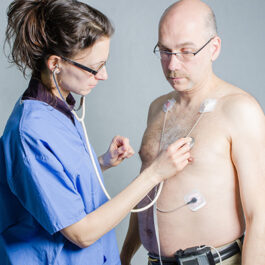
Ambulatory Electrocardiogram (Holter Monitor)
Purpose
The Holter monitor is a non-invasive portable system used to make a continuous digital recording of a patient’s heart rate and rhythm. This information may be required in order to detect any heart rhythm abnormalities, to adjust medications, or to match symptoms with heart activity.
Description
1. Five small areas on the patient’s chest are prepared for the electrodes. This involves cleaning the skin with alcohol, and rubbing the areas lightly with fine sandpaper. If necessary and the skin may be shaved for better electrode adhesion.
2. The wires are clipped onto the electrodes and an electrode is applied to each site. The wires are also secured to the electrodes by tape.
3. The wires and cable are connected to the Holter, which is then placed into a pouch and worn on a shoulder strap or belt.
4. The patient is instructed to press the Event button on the monitor and to record in the diary provided any symptoms experienced, including the time, circumstances, or activity associated with the symptom.
5. The equipment should be removed by the nurse at the clinic.
6. The data is analyzed by a qualified technologist, the information reviewed by a cardiologist, and a report sent to the referring doctor within 14 days of the monitor being returned. The referring doctor will inform the patient of the results.
Patient Instructions
Set up of the monitor will be done at the Plantagenet Family Health Team. Patients should bring a list of all their medications to the appointment and arrive 15 minutes prior to the scheduled time.
24 hours blood pressure monitor
An ambulatory blood pressure monitor is a portable blood pressure recording device. It is used to record blood pressure readings at specified times during a 24-hour period. The monitor consists of an arm cuff attached by a flexible rubber tube to a light-weight monitor. The monitor sits in a pouch secured to a waist belt or shoulder strap.
An ambulatory blood pressure monitor may be used to:
- Assess patients whose blood pressure tends to increase in the doctor’s office (white coat syndrome)
- Evaluate extent of hypertension (high blood pressure) or hypotension (low blood pressure)
- Monitor the effectiveness of blood pressure medications.
Description
- The monitor is worn for 24 hours.
- Unless otherwise programmed, the arm cuff inflates hourly, randomly for the 24 hours period.
- If the patient feels symptoms such as a rapid heart rate, dizziness, headache, or facial flushing, he or she should press a button on the monitor to take a manual blood pressure reading.
- The patient is asked to keep a diary of symptoms, vigorous activity, stressful episodes, schedule and dosage of blood pressure medication, time and quality of sleep, and time of awakening.
- The patient must return to see the nurse at the end of the 24-hour test period.
- The recorded data is reviewed by your family physician.
Patient Instructions
Set up of the monitor will be done by a nurse at Plantagenet Family Health Team. Patients should bring a list of all their medications to the appointment and arrive 15 minutes prior to the scheduled time.
